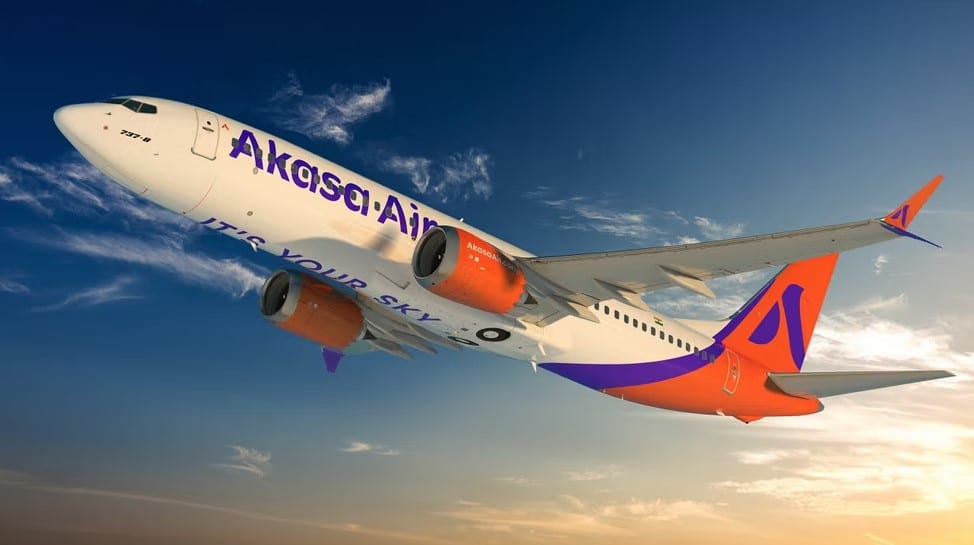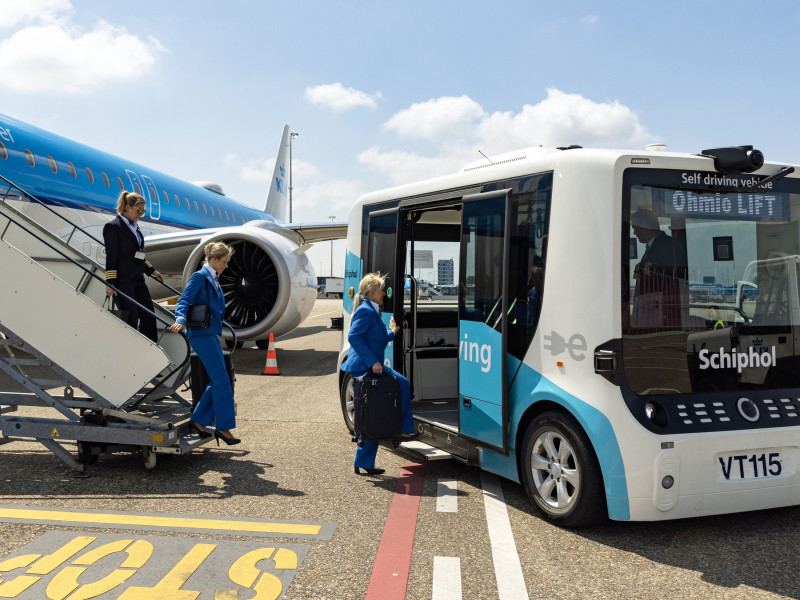Airlines
These are the 8 new records set by Akasa Air in the last six months.

Customers can fly with their pets on Akasa either in the cabin or in cargo, depending on the size of the animal. In India, only Air India previously permitted pets to fly in the cabin; all other airlines only permitted pets in the cargo hold. Recently, Akasa Air has begun to allow pets to fly in the cabin; however, it is only permitted to do so if the booking is made at least 48 hours before departure. Based on weight, the airlines have set pet prices. The pet needs a suitable cage and a medical certificate.
Like other airlines, this one allows dogs in the cargo hold. Pets between 7kg and 32kg that are checked in in the cargo area with a paying passenger will cost Rs 15,000 (GST inclusive). Moreover, costs for transporting larger dogs up to 100 kg in cargo “range based on weight and destination”.
2. Akasa Cabin uniforms
The majority of items for cabin crew are recognized when it comes to attire. Particularly female airline cabin crew have had to endure a lot of challenges due to their attire. Similar to the requirement to wear tight costumes, high heels, and some dress regulations. But, Akasa Air removed the obstacle for the airline staff. The cabin crew was given comfortable outfits and shoes so that they would not only look stylish but also feel at ease while wearing the attire. Shoes are created for the crew to wear from recycled rubber.
FAA Seeks to Lengthen Aircraft ‘Black Box’ Cockpit Recordings(Opens in a new browser tab)
3. The fastest-growing airline’s span of 6 month
Akasa began operating on August 7, 2022. The primary milestones were accomplished within six months, and utilization and expansion followed the airlines’ addition of fleets. By the end of the summer season, it will be flying 150 flights each day, up from its current 110 flights per day. While the expansion will continue, it won’t be for selfish reasons.
Over 700 weekly flights connecting 17 cities, including Ahmedabad, Bengaluru, Bhubaneshwar, Kochi, Chennai, Mumbai, Delhi, Guwahati, Agartala, Pune, Visakhapatnam, Lucknow, Goa, Hyderabad, Bagdogra, Kolkata, and Varanasi, have been operated by Akasa Air, which has carried over one million revenue passengers. The market share for Akasa Air rose sharply to 2.8%.
World’s Best Low-Cost Airlines 2022(Opens in a new browser tab)
4. Youngest fleet operator.
Akasa Air has made a definitive order for 72 CFM LEAP-1B engines-equipped Boeing 737 MAX aircraft. The airline’s aim to be an environmentally responsible business with the youngest and greenest fleet in the Indian skies is realized thanks to the 737 MAX series of aircraft, which offers superior efficiency in decreasing fuel use and carbon emissions. the airline currently has 19 flights going to 16 different places.
5. Within a year, Akasa will connect internationally.
Airlines show confidence in expanding their fleet internationally once domestic route operations have reached a required threshold and are utilising all available resources. The airline CEO announced recently that starting in 2023, there will be international connections to either the east or west of the continent. If this occurs, airlines are given preferential preference to transport foreign travelers while still serving domestic routes. Airlines now fly to 16 key locations with 19 planes.
6. The comfiest furnishings and seating.
Looking at low-cost airlines, it appears that they may offer some of the essential amenities that travelers require. To provide a welcoming, warm, pleasant, and effective flying experience, Akasa Air has created a number of market-leading, customer-friendly products, and services. The majority of Boeing 737 MAX airplanes have seats with USB connections, allowing passengers to charge their smartphones and gadgets. These seats have plenty of legroom. Future aircraft will be equipped with the newest USB ports.
7. Recycled materials for food packaging
The in-flight food service, Café Akasa, offers a variety of wholesome and delicious meals, festive menus, and unusual choices to give clients a luxurious, gourmet experience in the air. The focus of airlines is on recyclable and environmentally friendly packaging materials.
8. 50% of the women will be employed by Akasa.
50% of the female workforce in the fleet is the goal set by Akasa. No airlines in India have implemented any such policies in the recruitment for the empowerment of women, despite the fact that the airlines already employ 37% of women, a number that will rise to 50% in the coming days. As the airline continues to develop its fleet and routes, Akasa Air expects to add about 1,000 people, bringing the total staff size to more than 3,000 by the end of March 2024.

Airlines
KLM Begins Testing Self Driving Crew Buses at Schiphol Airport

In a significant step towards modernizing airport operations, Schiphol Airport has launched the second phase of its trial for electric self-driving buses.
This initiative, in collaboration with KLM Cityhopper and KLM Ground Services, is aimed at enhancing efficiency and sustainability at one of Europe’s busiest airports. Following a successful initial trial with the self-driving buses from supplier Ohmio, the new phase is now underway.
This phase focuses on deploying the autonomous buses on a fixed, pre-programmed route that connects the apron to the terminal. The primary users of this service are the KLM Cityhopper crew, who will benefit from a streamlined shuttle between their aircraft and the terminal. best cabin crew skytrax
Air France-KLM Orders 90 Airbus A350 Long-Range Aircraft:Click here
The trial’s first phase centered on assessing the technical capabilities and user-friendliness of the buses. Now, the focus shifts to the apron—a bustling area characterized by high activity levels, including aircraft movements and ground handling operations. The autonomous buses will navigate this complex environment multiple times a day, ferrying KLM Cityhopper crew from Apron A to the terminal.
Equipped with advanced sensors, cameras, and GPS, the buses are designed to handle the dynamic conditions of the apron. They feature LIDAR technology, providing a comprehensive 360-degree view that enables them to detect and avoid obstacles up to 30 meters away. This cutting-edge technology ensures safe and efficient operation in the busy airport setting.
Schiphol Airport is committed to becoming one of the world’s most sustainable and high-quality airports by 2050. A core component of this vision is the transition to a fleet of autonomous, zero-emission vehicles.
How to get admission in Emirates Aviation university?:Click here
This shift is part of a broader strategy to automate ground operations while maintaining a vital human presence in a supervisory role. By doing so, Schiphol aims to reduce emissions and enhance the overall efficiency of its operations.
The integration of self-driving buses into the airport’s daily operations represents a major milestone in achieving these sustainability goals. As the trial progresses, Schiphol, KLM Cityhopper, and KLM Ground Services will continue to evaluate and refine the technology, paving the way for a more automated and environmentally friendly future in aviation ground services.
-

 Travel1 week ago
Travel1 week agoAir India to Expand US Operations with Three New Routes After a Decade
-

 Travel2 weeks ago
Travel2 weeks agoWhy We Should Avoid These Stamps in a Passport
-

 Airlines1 month ago
Airlines1 month agoInvestigations Reveal Fake Chinese Titanium in Boeing and Airbus Jets
-

 Tech4 weeks ago
Tech4 weeks agoChina’s CATL Plans 1,800-Mile Electric Plane Launch by 2027
-

 Airport3 days ago
Airport3 days agoTop 10 Largest Airports in the World by Size
-

 Aerospace4 weeks ago
Aerospace4 weeks agoChina’s Fighter Jets Turn Wings into Autonomous Drones
-

 Airlines4 days ago
Airlines4 days agoAir India Rolls Out A350s for Delhi-New York JFK and Newark Routes
-

 Defence3 weeks ago
Defence3 weeks agoBoeing Enhances Chinook with New Engines and Block II Upgrades at $96 Million







